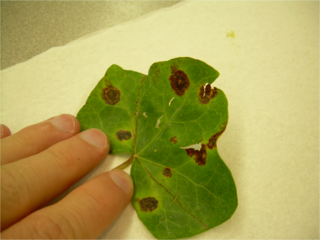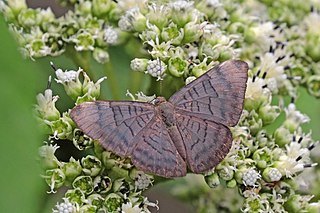
The Xanthomonadales are a bacterial order within the Gammaproteobacteria. They are one of the largest groups of bacterial phytopathogens, harbouring species such as Xanthomonas citri, Xanthomonas euvesicatoria, Xanthomonas oryzae and Xylella fastidiosa. These bacteria affect agriculturally important plants including tomatoes, bananas, citrus plants, rice, and coffee. Many species within the order are also human pathogens. Species within the genus Stenotrophomonas are multidrug resistant opportunistic pathogens that are responsible for nosocomial infections in immunodeficient patients.

The glassy-winged sharpshooter is a large leafhopper, similar to other species of sharpshooter.

Xylella fastidiosa is an aerobic, Gram-negative bacterium of the genus Xylella. It is a plant pathogen, that grows in the water transport tissues of plants and is transmitted exclusively by xylem sap-feeding insects such as sharpshooters and spittlebugs. Many plant diseases are due to infections of X. fastidiosa, including bacterial leaf scorch, oleander leaf scorch, coffee leaf scorch (CLS), alfalfa dwarf, phony peach disease, and the economically important Pierce's disease of grapes (PD), olive quick decline syndrome (OQDS), and citrus variegated chlorosis (CVC). While the largest outbreaks of X. fastidiosa–related diseases have occurred in the Americas and Europe, this pathogen has also been found in Taiwan, Israel, and a few other countries worldwide.

Graphocephala coccinea is a meadow and woodland-dwelling species of brightly colored leafhopper native to North and Central America, from Canada south to Panama. Common names include candy-striped leafhopper, red-banded leafhopper, scarlet-and-green leafhopper and red-and-blue leafhopper.

Vitis tiliifolia is a New World liana in the grape family commonly known as Caribbean grape. Other names include West Indian grape, water vine, Agrá and Bejuco de Agua and water tie-tie and water-wise.
Actinokineospora is a genus in the phylum Actinomycetota (Bacteria).

Emesis lucinda is a butterfly of the family Riodinidae. It is found from Mexico to Bolivia and in Suriname, French Guiana and Brazil.
Tepilia is a genus of moths of the family Phiditiidae first described by Francis Walker in 1855.
Eriphioides fastidiosa is a moth of the subfamily Arctiinae. It was described by Harrison Gray Dyar Jr. in 1916. It is found in Central America.
Parapsectris fastidiosa is a moth in the family Gelechiidae. It was described by Edward Meyrick in 1911. It is found in the South African province of Limpopo and in Namibia.
Desulfofaba fastidiosa is a bacterium from the genus of Desulfofaba which has been isolated from sediments in Denmark.
Tepilia dodala is a moth in the Phiditiidae family. It was described by Schaus in 1927.

Graphocephala atropunctata, commonly known as the blue-green sharpshooter, is a hemipteran bug endemic to California. It carries the phytopathogenic bacteria Xylella fastidiosa which infects the xylem of grape vines causing die-back – known as Pierce's disease. This leads to loss of productivity and economic damage to the California vineyards.
Hyperaspis fastidiosa, the fastidious lady beetle, is a species of lady beetle in the family Coccinellidae. It is found in North America.
Verdale-de-l'Hérault is an olive cultivar developed in the department of Hérault, in the southern French region of Occitanie. The fruit produces a sweet oil with a light and fruity aroma of greenery, nuts, and apple, and exhibits no bitterness.
Blastocatella is a genus of bacteria from the family of Blastocatellaceae with one known species. Blastocatella fastidiosa has been isolated from savanna soil from Erichsfelde in Namibia.

Olive quick decline syndrome (OQDS) is a wasting disease of olive trees which causes dieback of the leaves, twigs and branches so that the trees no longer produce crops of olives. The main cause is a strain of the bacterium, Xylella fastidiosa, which is spread by plant-sucking insects such as the meadow froghopper. The bacteria restrict the flow of sap within the tree and so choke its extremities.
Pecan bacterial leaf scorch is a disease of the pecan tree that is common throughout the production regions of the United States caused by the pathogenic bacterium Xylella fastidiosa subsp. multiplex. The pathogen was initially discovered to be coincidentally associated with symptoms of pecan fungal leaf scorch in 1998 and has subsequently been found to be endemic in the southeastern United States, as well as Arizona, California, and New Mexico.

Nuculana is a genus of bivalves in the family Nuculanidae. It includes the following species:








